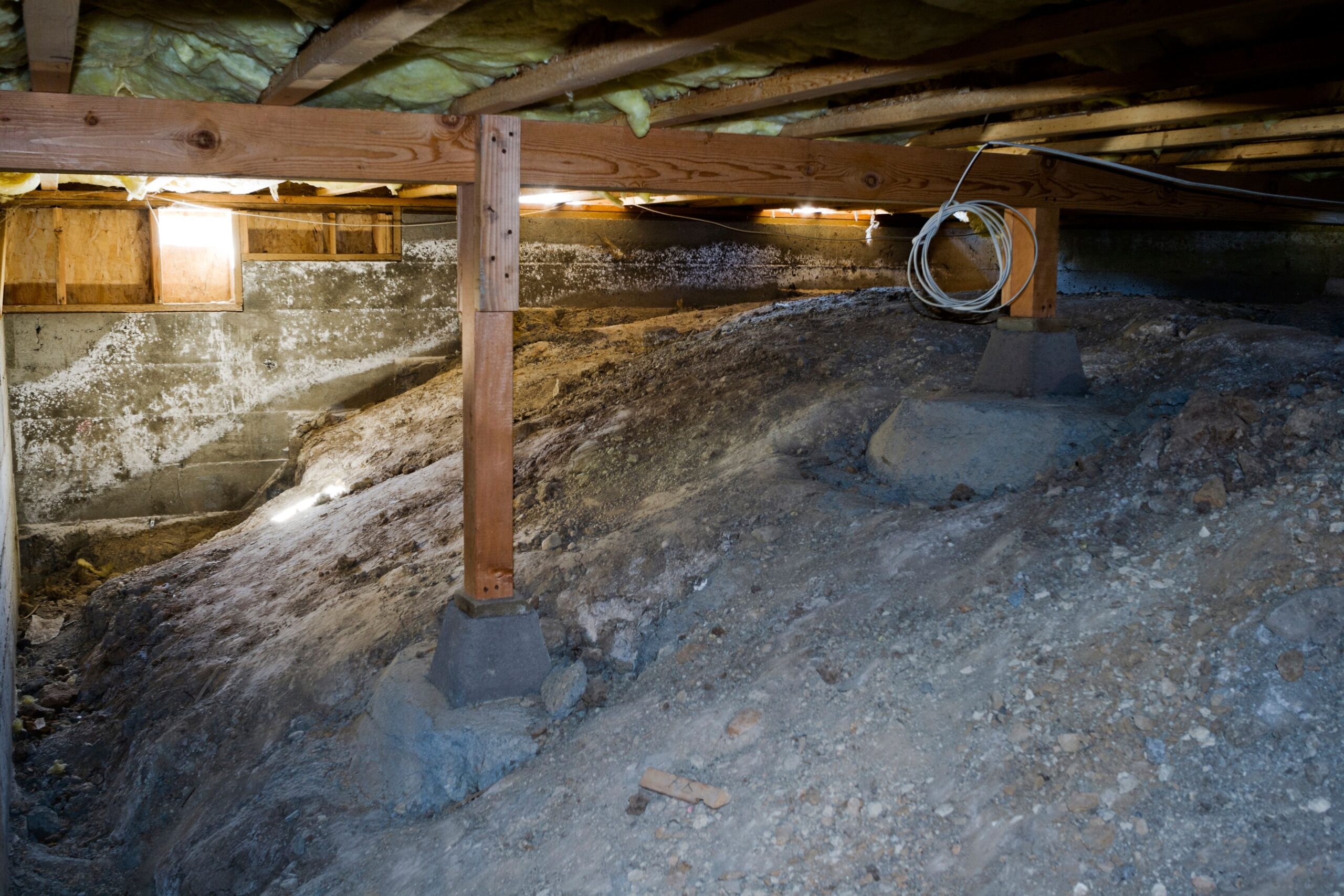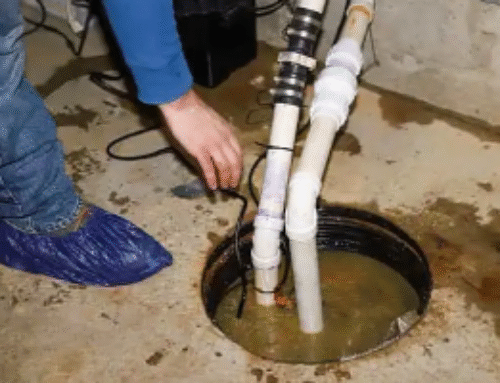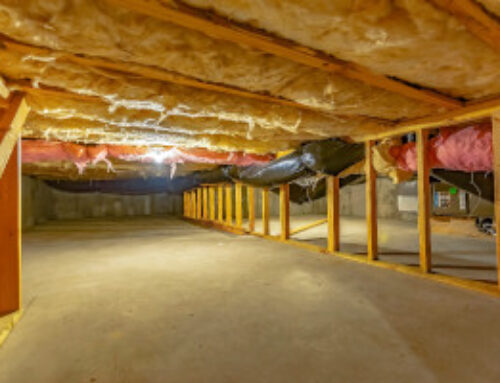If you’re here, you’re probably looking for a way to protect your house from the damp, humid conditions that start right under your feet, in the crawl space.
The truth is that nearly 50% of the air inside your home can originate from the crawl space. If it’s full of moisture, this can lead to mold growth, poor air quality, and even structural damage over time.
In this case, the most effective way is to install a crawl space vapor barrier to keep your home dry, healthy, and energy-efficient. We’ll show you how to do it yourself, but first, let’s take a look at what a vapor barrier is and what it does.
What is a Crawl Space Vapor Barrier?
A crawl space vapor barrier is a thick plastic sheet, usually made from polyethylene, that covers the ground and sometimes the walls of your crawl space. Its main job is to block moisture from the soil below from rising into your home.
Without this barrier, moisture can seep upward, increasing humidity levels, encouraging mold growth, and even weakening your home’s foundation over time.
Most vapor barriers are between 6 to 10 mil thick, and they come in rolls that can be cut and shaped to fit the dimensions of your space. When installed properly, they create a sealed layer that protects your crawl space and, ultimately, your entire home.
Why a Crawl Space Vapor Barrier Matters
Crawl space moisture issues may seem harmless, but over time, they can wreak havoc on your home’s structure, indoor air quality, and energy bills. This is where a moisture barrier comes in handy and acts as your fine line of defense against these problems.
In short, it’s a simple upgrade that offers big returns, both for your home’s health and your peace of mind.
5 Signs Your Crawl Space Needs a Vapor Barrier
Not if your home needs a vapor barrier? Your crawl space might already be sending you warning signs for crawl space repairs, including:
1. Musty Odors in the Home
One of the first signs of moisture buildup in a crawl space is a persistent musty or damp smell inside the house. These odors come from mold and mildew that thrive in humid, unsealed spaces.
2. High Indoor Humidity Levels
If you constantly feel like your home is sticky or muggy, even when the weather outside is normal, your crawl space could be the culprit. Moisture rising from the ground adds to the humidity inside your home, making it harder to keep comfortable.
3. Visible Condensation or Standing Water
If you see water pooling or condensation forming on crawl space surfaces like pipes, ductwork, or insulation, that’s a clear sign of excess moisture. Left untreated, standing water can lead to mold growth, rust, and even attract pests.
4. Sagging Floors or Wood Rot
Excess humidity can cause wooden beams and floor joists to absorb water, leading to sagging floors, soft softs, and visible wood rot. This type of damage is expensive to fix but preventable with a vapor barrier.
5. Pests and Critters Attracted to Damp Spaces
Damp crawl spaces are a magnet for pests like termites, carpenter ants, spiders, and rodents. These creepy critters thrive in moist environments and can enter your living space through cracks or vents.
Crawl Space Vapor Barrier Cost: What to Expect
Now, let’s talk numbers because we know you’ve been wondering.
If you go the DIY route, a crawl space vapor barrier installation typically costs between $0.50 to $1.50 per square foot, depending on the thickness of the plastic and any extra supplies you might need. That means for a 1,000 sq. ft. crawl space, you’re looking at $500 to $1,500 in total.
On the flip side, if you hire a pro, costs jump up to $3 to $7 per square foot, which can easily total $3,000 to $7,000 or more. You’ll pay more, but you also get professional-grade sealing, possible warranties, and a faster job.
Is it worth it? If you’re dealing with serious moisture or just want peace of mind, absolutely. But if you’re handy and up for the challenge, DIY can save thousands.
Reasons to Install a Crawl Space Vapor Barrier
Installing a vapor barrier is a proactive step toward safeguarding your home’s structure, air quality, and long-term energy costs. Here’s how this simple solution can make a big impact:
Preventing Mold and Mildew Growth

Crawl spaces are often dark, poorly ventilated, and are directly on damp soil which creates the perfect breeding ground for mold and mildew. When moisture seeps up from the ground, it settles on wooden beams and other organic materials under your home.
This trapped moisture creates a humid environment where mold spores can grow within just 24 to 48 hours.
This is where a moisture barrier blocks that ground moisture from rising into the crawl space, keeping surfaces dry and inhospitable to mold and mildew. This protects the structural integrity and prevents unpleasant odors.
Improving Indoor Air Quality
What happens in your crawl space doesn’t stay there. Due to a process called the stack effect, air naturally moves upward through your home. That means any mold spores, dust, or high humidity in the crawl space can get pulled into your living areas.
However, by sealing off the crawl space with a vapor barrier, you can drastically reduce the chance of pollutants and allergens entering your home. This is especially beneficial if anyone in your household has asthma or other respiratory conditions.
Boosting Energy Efficiency
Moisture in a crawl space not only leads to biological problems, but also affects your home’s thermal performance. High humidity levels force your HVAC system to work harder to maintain a comfortable indoor temperature, which can increase your utility bills significantly.
Using a vapor barrier in this situation helps maintain a stable environment beneath your home. This in turn helps regulate indoor temperatures more efficiently.
In fact, the Department of Energy also says that sealing and insulating your crawl space can reduce heating and cooling costs by up to 20%.
Crawl Space Insulation vs Vapor Barrier: What’s the Difference?

Many homeowners confuse insulation with crawl space vapor barriers, but they serve very different purposes and ideally you should have both.
A vapor barrier, as you know, is designed to stop ground moisture from entering the crawl space. Meanwhile, insulation is meant to regulate temperature. It’s typically installed along the crawl space walls or between floor joists to prevent heat loss in winter and keep cool air in during summer.
Think of it this way:
- Vapor barriers protect against moisture.
- Insulation protects against temperature swings.
- Together, they create a dry, energy-efficient foundation that improves indoor comfort and prevents long-term damage to your home.
FAQs
Protect Your Crawl Space, Protect Your Home
Installing a crawl space vapor barrier is one of the smartest investments you can make to protect your home from moisture damage, poor air quality, and rising energy bills. But moisture control doesn’t stop there.
For long-term protection, you may need more than just a vapor barrier such as full crawl space encapsulation or waterproofing. That’s where our crawl space repair services come in handy.
At Crossroads Foundation Repair, we specialize in lasting solutions that go far beyond a quick fix.
Schedule your evaluation today and don’t wait for musty odors or sagging floors to get worse!




